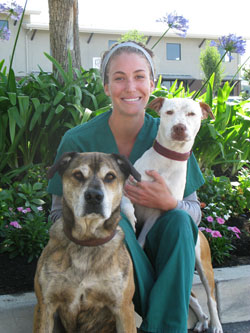Written by Richard Tao, DVM
Americans, particularly Californians, are considered innovators and early adopters of going green. I am sure that we can all agree that a clean environment is better for ones health and that practicing energy efficiency can help bring huge cost savings. Yet, how can going green also be carried over to owning pets? After a bit of research I found that pet ownership, sadly, is not the most sustainable practice and that the most carbon neutral pet you can own is a goldfish! Let’s face it. Every day we plop giant bags of dog food and buckets of kitty litter into our gas guzzling SUVs and head over to the dog park to take Fluffy out to breathe in the fresh air. Then we zoom over to Animal Care Clinic to pick up Fluffy’s heartworm preventative right before dropping her off at the day spa for a pedicure. There’s no doubt we as pet owners can all do just a little bit more to help mother earth.
Fortunately, there are some simple steps we can take to help reduce our carbon footprint and Fluffy’s carbon pawprint.
Americans, particularly Californians, are considered innovators and early adopters of going green. I am sure that we can all agree that a clean environment is better for ones health and that practicing energy efficiency can help bring huge cost savings. Yet, how can going green also be carried over to owning pets? After a bit of research I found that pet ownership, sadly, is not the most sustainable practice and that the most carbon neutral pet you can own is a goldfish! Let’s face it. Every day we plop giant bags of dog food and buckets of kitty litter into our gas guzzling SUVs and head over to the dog park to take Fluffy out to breathe in the fresh air. Then we zoom over to Animal Care Clinic to pick up Fluffy’s heartworm preventative right before dropping her off at the day spa for a pedicure. There’s no doubt we as pet owners can all do just a little bit more to help mother earth.
Fortunately, there are some simple steps we can take to help reduce our carbon footprint and Fluffy’s carbon pawprint.
 Scoop the poop! The first step is hopefully a no brainer. Not only is proper disposal of your pets poop socially responsible it’s the healthy thing to do. Use biodegradable bags instead of plastic bags that will take hundreds of years to break down. I discovered some kitty litters are extracted from mines using incredibly destructive strip mining techniques. Products made from renewable resources are a good alternative. Flushable cat litters should be avoided. New research suggests a link between parasites from cats to recent die-off marine mammals due to sewage run off.
Scoop the poop! The first step is hopefully a no brainer. Not only is proper disposal of your pets poop socially responsible it’s the healthy thing to do. Use biodegradable bags instead of plastic bags that will take hundreds of years to break down. I discovered some kitty litters are extracted from mines using incredibly destructive strip mining techniques. Products made from renewable resources are a good alternative. Flushable cat litters should be avoided. New research suggests a link between parasites from cats to recent die-off marine mammals due to sewage run off.- Spay or neuter your pet. Overcrowding in shelters is becoming an unfortunate reality. Let’s help keep this tragic thing from happening.
- Use sustainable goods. That new squeaky toy for Fluffy on aisle 5. Well it’s probably made from plastics in a toxic factory overseas. Imagine freight cars full of rubbery and smelly squeaky toys floating in a container ship across the ocean just so Fluffy can tear it to shreds in the blink of an eye. Then recall the hours of entertainment he had crawling in and out of the cardboard box it came in. Cardboard box wins every time.
- Plan your pet outings. Those separate trips to the dog park, pet store, groomer, and veterinarian all add up to lots of gas. Plan your route to group your pet outings together. Most pet stores allow you to bring your leashed dog into the store so there isn’t a worry about leaving them in a hot car.












